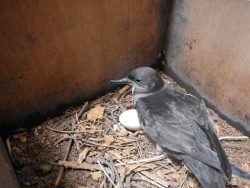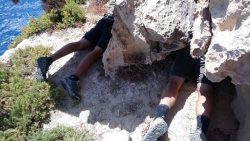Yelkouan Shearwaters visit the Maltese Islands every year to breed between February and July, which means that now the colonies are empty while the birds spend some months at sea. The LIFE Arċipelagu Garnija team is also back to their desks after a busy field season. This year has probably been the most successful year for this endangered species in the Maltese Islands yet, due to the conservation actions implemented by the LIFE project and partners.
The best way to measure colony success is by the number of young birds that successfully make it to fledging and this year we are very proud to have ringed 130 chicks and fledglings from nine accessible colonies. This is mostly thanks to the rat control first implemented in several colonies this year and yet again at L-Irdum tal-Madonna. We hope that the continuation of this program will lead to an even larger success in 2019, even if this year’s record will be hard to beat. The rat control was perhaps most successful on St. Paul’s Islands which saw the biggest transformation with the removal of rats from the islet. Six of the eight nests being monitored were successful in that the chicks made it to fledgling compared to the one out of the nine nests monitored in 2017.
Nest box occupancy doubled this year too, with four occupied at L-Irdum tal-Madonna. Three healthy fledglings made it out to sea from these. Happily we can also report that a Yelkouan Shearwater pair have been prospecting our nest boxes at St. Paul’s Islands so we hope they will choose one to nest in next year.
Our Yelkouan Shearwaters have also been in the spotlight through #NestWatch. This has been a pleasure as we have watched the chick hatch, grow and fledge, through visits to the colonies and through the footage itself, recording new behaviours and giving an insight into these secretive seabirds. Stay tuned for a video summarizing the whole season’s footage and if you have missed out on previous clips, visit here.
Earlier this year we again celebrated the return of the European Storm-petrel pair nesting at L-Rdum tal-Madonna. Sadly, though, despite the seasonal rat control that has been going on since 2007, the egg was predated by a rat in July. Unfortunately localised rat control is not a guarantee that no rats will make it through to the colony and shows the importance of reducing litter in the surrounding cliff tops so that the rat population is kept as low as possible. This is something all members of the public as well local councils can play a part in.
While the threat of rats to Yelkouan Shearwaters has been reduced, they still face several other threats. Light pollution has always been a problem for fledging shearwaters and this year was no different with a record of nine birds found stranded in urban areas by members of the public. Eight of the stranded birds bounced back from the initial shock and were successfully released back to sea. We look forward to working with local councils and business owners to help reduce and mitigate the effects of light pollution! Finally we are pleased to have this summer presented Transport Malta – a partner in our LIFE Arċipelagu Garnija project – proposals to reduce light and noise pollution from boats and ships close to Yelkouan Shearwater colonies.
By Martin Austad, LIFE Arċipelagu Garnija Project Warden


